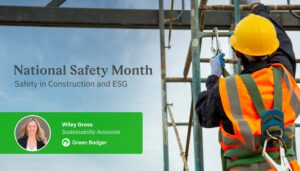
This is part three of our ESG blog series, and we will discuss how subcontractor participation influences ESG tracking and reporting.
The steps described in this post should be considered after you’ve already gotten a handle on the things your company controls, and the things you have a strong influence on. After you have started benchmarking, goal setting, and tactic implementation and tracking for your own company, you can focus on getting your subcontractors involved in ESG reporting. Subcontractors play a key role in the success of any project and have an impact on several ESG metrics, including:
- Energy use: if subcontractors have their own office or trailer on site, they are producing carbon emissions associated with the project. When subcontractors use equipment and machinery that is powered by electricity, gas, or diesel, emissions are produced on site.
- Commute emissions: getting all subcontractors to and from the project site every day can have a huge impact, especially if using large trucks which are common vehicles seen on construction sites.
- Product transportation & waste hauling: Subcontractors may source materials from diverse locations, leading to varying levels of carbon intensity in the transportation process. Similarly, hauling waste and recycling to processing facilities contributes to carbon emissions.
- Waste Processing: carbon emissions are produced when recycling materials and when emissions break down in landfills.
- M/WDBE Participation: Encouraging and facilitating the participation of M/WDBEs in project activities can foster diversity, equity, and social inclusion, directly impacting the social aspect of ESG reporting. Tracking their involvement can contribute positively to overall ESG goals.
- Local Participation: Partnering with local vendors reduces the carbon footprint associated with transportation, supports the local economy, and promotes community involvement. Including these entities in the supply chain can positively influence both environmental and social aspects of ESG performance.

If you are going to require that subcontractors provide certain ESG information, it is important that this expectation be communicated as early as possible. I have heard that putting it in the bid documents can allow the trades to account for any potential costs that may be associated with gathering and tracking information, and it ensures that once subs are selected, they are already aware that this is a requirement of the job.
The reason that including subcontractor impact in ESG should be one of the last things you focus on is that getting this information is going to be more challenging since multiple companies will need to be involved in this effort, and you may have to provide educational resources and guidance to get the information you need. And that process can become even more complicated when you multiply that by the total number of different trade companies on a project. It might be beneficial to start this request on a smaller project with fewer trades to try and work out any kinks in the process. Or, you could start with the trades that have the largest impact (either the largest scope of work, or duration on site) and eventually work your way up to including the smaller ones.
At this point, there is no right or wrong way to get subcontractors involved with ESG tracking. If you have any lessons learned or best practices, please add a comment below to let us know what worked and what didn’t!






